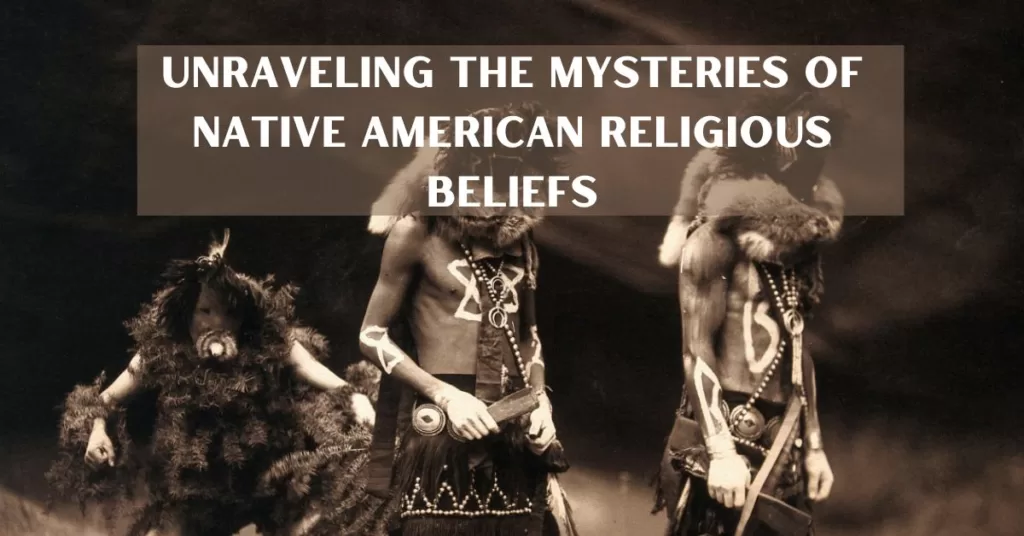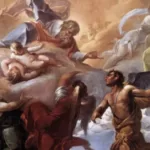Native American religious beliefs have long been a fascinating and complex topic for those seeking to understand the diverse spiritual landscape of indigenous cultures. This article takes you on a journey through the intricacies of Native American spirituality, exploring the deep connections with nature, the significance of rituals and ceremonies, and the blending of traditional beliefs with other faiths. We also delve into the modern adaptations and revival of these ancient practices, highlighting the resilience of these spiritual traditions in the face of adversity and change. Join us as we unravel the mysteries and celebrate the rich heritage of Native American religious beliefs.
Table of Contents
A Glimpse into Native American Spiritual Beliefs
Diving into the diverse world of Native American spiritual beliefs, we embark on a journey of discovery that reveals the profound connections these indigenous people share with the world around them. This section will explore the relationship between nature and Native American spirituality, highlighting the essential role that animals and plants play in their belief systems. We will also delve into the concept of the Great Spirit and other deities, showcasing the rich tapestry of beliefs that varies across tribes and regions. By understanding the core values and principles that guide Native American religious beliefs, we can gain a deeper appreciation for their rich cultural heritage and unique spiritual perspectives.
Connection to nature and the environment
Native American spiritual beliefs are deeply rooted in their profound connection to nature and the environment. This intrinsic bond reflects their understanding of the world as a living, interconnected system where every element plays a significant role. For many Native American tribes, the natural world is infused with spiritual energy, and they see themselves as caretakers of the land, responsible for maintaining its delicate balance.
Animals and plants hold a special place in Native American religious beliefs, often serving as symbols, teachers, and guides. Many tribes believe that every animal and plant has a spirit and can impart valuable lessons to those who are receptive. For example, the eagle, revered for its ability to soar high above the earth, represents wisdom, strength, and spiritual vision. Similarly, plants like sage, cedar, and sweetgrass are considered sacred for their purifying and healing properties. These living beings are integral to Native American rituals and ceremonies, helping people connect with their spiritual essence and the greater web of life.
The Great Spirit and other deities
At the heart of many Native American spiritual beliefs lies the concept of the Great Spirit, an all-encompassing, omnipotent force that governs the universe. This supreme being, known by different names across tribes, is often seen as the creator and sustainer of life, and the source of all wisdom and power. In addition to the Great Spirit, Native American religious beliefs include a diverse pantheon of deities, spirits, and supernatural entities that govern various aspects of the natural world. These lesser gods and spirits play an important role in their spiritual practices, as they’re invoked for protection, guidance, and blessings.
While there are common threads that run through Native American spiritual beliefs, it’s important to recognize the incredible diversity that exists among the many tribes and regions. Each tribe has its unique set of beliefs, rituals, and ceremonies, shaped by factors such as geography, history, and cultural exchange. For instance, the Hopi people of the Southwest emphasize the importance of harmony with the land and its resources, while the Lakota people of the Plains region place a strong focus on individual spiritual growth and vision quests. This rich tapestry of beliefs is a testament to the adaptability and resilience of Native American spirituality, as well as the deep understanding they have of their natural surroundings.
Native American Religious Practices and Rituals
As we delve deeper into the world of Native American religious beliefs, it becomes evident that their spiritual practices and rituals play a pivotal role in expressing and maintaining their connection with the sacred. In this section, we will examine the ceremonies that mark important life events and communal gatherings, highlighting the significance of dance, music, and storytelling in these rites. We will also explore the crucial role of the medicine man or shaman, whose spiritual healing practices and herbal remedies have been passed down through generations. Lastly, we’ll discuss the use of sacred objects and symbols, shedding light on their importance in Native American religious practices. Join us as we uncover the intricate layers of tradition and meaning that make these rituals a vital aspect of Native American spirituality.
Sacred ceremonies
Sacred ceremonies play an essential role in Native American religious practices, offering a means for communities to come together and honor the spiritual forces that guide their lives. These rituals often mark significant life events, such as births, marriages, and deaths, as well as seasonal changes and other occasions. Through these ceremonies, participants foster a sense of unity and shared spiritual purpose, while reinforcing their connection with their ancestors and the divine.
Dance, music, and storytelling are integral components of Native American sacred ceremonies, weaving together a tapestry of cultural expression and spiritual connection. Dance serves as a conduit for participants to communicate with the spirit world, embodying the essence of animals, ancestors, or supernatural beings. Music, often in the form of drumming, singing, or chanting, enhances the emotional and spiritual resonance of the ceremonies, enabling participants to enter a heightened state of awareness. Storytelling, meanwhile, helps preserve and transmit the tribe’s history, values, and beliefs, fostering a sense of continuity and shared identity.
The role of the medicine man or shaman
The medicine man or shaman holds a revered position within Native American communities, acting as a spiritual leader, healer, and intermediary between the human and spirit worlds. Often chosen through a combination of heredity, personal calling, and rigorous training, these individuals possess deep knowledge of their tribe’s religious beliefs and practices, as well as the natural world. They serve as guardians of sacred traditions, ensuring their survival and transmission to future generations.
Native American religious practices encompass a wealth of spiritual healing techniques and herbal remedies, reflecting their intimate connection with the natural world. The medicine man or shaman employs methods such as prayer, meditation, and the use of sacred objects to facilitate healing on physical, emotional, and spiritual levels. Herbal remedies, derived from the rich variety of plants found in their environment, are also employed to treat a wide range of ailments. These healing practices, grounded in the belief that health and well-being are inseparable from spiritual harmony, remain an important aspect of Native American spirituality.
The use of sacred objects and symbols
In Native American religious practices, sacred objects and symbols serve as powerful reminders of the tribe’s spiritual beliefs and values. These items, often imbued with spiritual energy, help to focus the practitioner’s intent and channel the forces of the spirit world. Examples of such objects include medicine bundles, prayer sticks, and ceremonial pipes, each with its unique significance and purpose.
Among the many sacred objects and symbols found in Native American religious practices, the dreamcatcher, totem poles, and other artifacts hold special significance. The dreamcatcher, a woven hoop adorned with feathers and beads, is believed to protect its owner from negative dreams, allowing only positive visions to pass through. Totem poles, meanwhile, serve as monumental carvings that represent the lineage, legends, and spiritual beliefs of the tribes who create them. These artifacts, along with countless others, provide a tangible link to the rich spiritual heritage of Native American peoples, bearing witness to the resilience and diversity of their religious beliefs.
What Religion Do Native Americans Believe In: The Diversity of Beliefs
As we continue our exploration of Native American religious beliefs, it’s crucial to recognize that there is no single, monolithic “Native American religion.” Instead, the spiritual landscape of these indigenous peoples is marked by a rich and vibrant tapestry of beliefs that span numerous tribes and geographic regions. In this section, we’ll delve into the diversity of Native American spiritual beliefs, providing an overview of some of the most prominent and unique religious systems that have developed over time. By gaining an understanding of the complex and varied nature of these beliefs, we can appreciate the ingenuity and adaptability of Native American spirituality, as well as the incredible depth and richness of their cultural heritage.
Pan-Indianism and the Native American Church
Pan-Indianism is a movement that seeks to promote unity and solidarity among Native American tribes, transcending their diverse spiritual beliefs and cultural backgrounds. One manifestation of this movement is the Native American Church, which combines elements of traditional Native American spirituality with aspects of Christianity. Founded in the late 19th century, the Native American Church has provided a means for indigenous people to maintain their spiritual identity and cultural heritage while adapting to the challenges of modern life.
The encounter with European colonizers and missionaries led to significant changes in Native American religious beliefs, including the blending of traditional spiritual practices with Christianity. Many tribes have incorporated Christian elements into their religious systems, creating unique syncretic faiths that preserve their indigenous spiritual heritage while embracing new beliefs. This fusion of religious traditions has given rise to a diverse and dynamic spiritual landscape, reflecting the resilience and adaptability of Native American cultures.
The impact of colonization and forced conversions
The colonization of the Americas brought devastating consequences for Native American peoples, including the forced conversion to Christianity and the suppression of their traditional spiritual practices. Missionaries, often backed by colonial governments, sought to “civilize” indigenous people by imposing European religious beliefs and eradicating their native spiritual traditions. This process resulted in the loss of countless religious practices, sacred sites, and spiritual knowledge, as well as the disruption of communal bonds and cultural continuity.
Despite the immense challenges posed by colonization and forced conversions, Native American spiritual beliefs have endured and evolved, demonstrating the strength and resilience of their cultural heritage. Many tribes have managed to preserve their spiritual practices, passing them down through generations and adapting them to changing circumstances. In recent years, there has been a resurgence of interest in Native American spirituality, both among indigenous people seeking to reconnect with their ancestral beliefs and non-Native individuals drawn to the wisdom and holistic worldview of these ancient traditions. This revival of interest testifies to the enduring appeal and relevance of Native American religious beliefs in the modern world.
The Revival and Modern Adaptations of Native American Religious Beliefs
In the face of centuries of colonization, forced conversion, and cultural assimilation, Native American religious beliefs have demonstrated remarkable resilience and adaptability. Today, we witness a revival and renaissance of indigenous spirituality, as Native Americans and non-Natives alike seek to reconnect with the wisdom and beauty of these ancient traditions. In this section, we will explore the factors contributing to this resurgence, as well as the ways in which Native American religious beliefs are being adapted and reinterpreted in modern contexts. As we embark on this journey, we will gain a deeper appreciation for the enduring power and relevance of Native American spiritual beliefs, and their ability to inspire and guide us in our contemporary world.
The American Indian Religious Freedom Act of 1978
The American Indian Religious Freedom Act (AIRFA) of 1978 marked a significant turning point in the recognition and protection of Native American religious rights. This landmark legislation sought to address the longstanding suppression of indigenous spiritual practices by guaranteeing Native Americans the freedom to believe, express, and practice their traditional religions. The passage of AIRFA helped to pave the way for the revival of Native American religious beliefs and the reclamation of their spiritual heritage.
The recognition and protection of Native American religious rights have contributed to the resurgence of traditional spiritual practices and the revitalization of indigenous cultures. The restoration of religious freedoms has enabled Native American communities to openly practice their faiths, preserve their sacred sites, and pass down their spiritual knowledge to future generations. This renewed access to their ancestral beliefs has fostered a greater sense of cultural pride, identity, and continuity among Native Americans, empowering them to confront the challenges of modern life with the guidance of their spiritual traditions.
Contemporary Native American spirituality and religious practices
In the modern era, Native American spirituality has continued to evolve and adapt to changing social, cultural, and environmental conditions. Contemporary Native American religious practices often incorporate both traditional and non-traditional elements, reflecting the diverse and dynamic nature of indigenous spiritual beliefs. This ongoing process of adaptation and reinterpretation demonstrates the enduring relevance of Native American spiritual wisdom in addressing the challenges and uncertainties of today’s world.
The revival of Native American religious beliefs has been influenced, in part, by the rise of New Age movements and interfaith dialogue. Many people from diverse cultural and religious backgrounds have been drawn to the holistic, nature-centered, and community-oriented aspects of Native American spirituality. This growing interest has facilitated cross-cultural exchange and collaboration, fostering greater understanding and appreciation for the richness and depth of indigenous spiritual traditions. The influence of New Age movements and interfaith dialogue has also helped to raise awareness about the importance of preserving and revitalizing Native American religious beliefs, ensuring their continued survival and growth in the 21st century.
Conclusion
In conclusion, the resilience and adaptability of Native American religious beliefs have allowed these ancient spiritual traditions to endure and evolve through centuries of change and adversity. The revival of interest in these beliefs highlights the importance of preserving and respecting indigenous spiritual practices, as they hold valuable wisdom and insights that can guide and inspire us in our modern world. By learning about and honoring the rich tapestry of Native American spiritual beliefs, we can deepen our understanding of their cultures and promote greater tolerance, respect, and appreciation for the diverse religious landscapes that make up our shared human experience.
FAQ:Mysteries of Native American Religious Beliefs
What is the basis of Native American religious beliefs?
Native American religious beliefs are deeply rooted in the connections to nature, the environment, and the spiritual world. The beliefs and practices vary across tribes and regions, but generally emphasize the importance of animals, plants, and the elements in their spiritual worldview.
What is the role of the medicine man or shaman in Native American religious practices?
The medicine man or shaman serves as a spiritual leader, healer, and intermediary between the physical and spiritual worlds. They are responsible for conducting ceremonies, providing guidance, and offering healing practices using herbal remedies and spiritual techniques.
How have Native American religious beliefs been influenced by Christianity?
Many Native American tribes have blended traditional beliefs with Christianity due to historical interactions, colonization, and forced conversions. This has resulted in the emergence of unique religious practices that combine elements from both indigenous spirituality and Christian teachings.
What is the American Indian Religious Freedom Act of 1978?
The American Indian Religious Freedom Act (AIRFA) is a U.S. federal law that aims to protect and preserve the religious rights of Native Americans, allowing them to practice their traditional faiths and spiritual customs without interference or discrimination.
How have Native American religious beliefs adapted and evolved in the modern era?
Native American religious beliefs have demonstrated resilience and adaptability, evolving in response to changing social, cultural, and environmental conditions. Contemporary Native American spirituality often incorporates both traditional and non-traditional elements, reflecting the diverse and dynamic nature of indigenous spiritual beliefs.
What is the relationship between Native American religious beliefs and New Age movements?
New Age movements have been influenced by Native American spirituality, particularly in their emphasis on holistic, nature-centered, and community-oriented practices. This has facilitated cross-cultural exchange and collaboration, fostering greater understanding and appreciation for the richness of indigenous spiritual traditions.
How can we contribute to the preservation of Native American religious beliefs and practices?
By learning about, respecting, and appreciating the rich tapestry of Native American spiritual beliefs, we can help to raise awareness about the importance of preserving these traditions. Supporting indigenous communities, respecting their cultural heritage, and advocating for their religious rights can also contribute to the continued survival and growth of Native American religious beliefs.

Joyce Ann Tyldesley is a renowned British archaeologist, Egyptologist, writer, and broadcaster.






